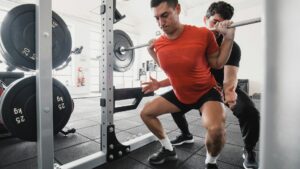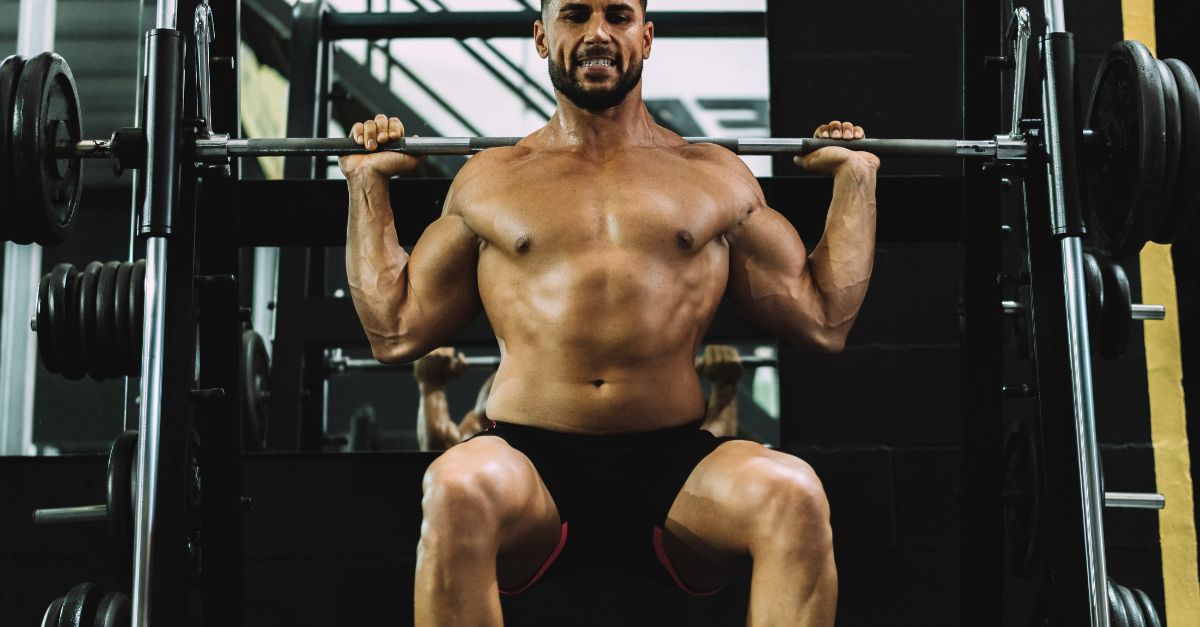Hey there, fitness enthusiasts! If you’ve ever set your sights on conquering the mighty 200-pound squat, you know it’s no small feat.
But here’s the twist: is packing on extra muscle mass the secret sauce to reach this milestone, or could it be a sign that your workout plan needs a tune-up? Join us as we unravel the mystery of whether mass gain is a necessity or a red flag pointing to programming errors on your quest for the coveted 200-pound squat. Let’s dive in! 💪🏋️♂️
Exploring whether Mass Gain is Necessary when Striving for a 200-pound Squat.
Striving for a 200-pound squat is a reasonable and attainable goal for many individuals, but whether mass gain is necessary or indicates programming errors depends on various factors, including your current fitness level, goals, and training approach. Let’s break down the considerations:
Current Fitness Level: If you’re already at a point where you can squat close to 200 pounds with good form, you might not need significant mass gain to reach this goal.
Your focus may be more on strength and technique improvement.
Body Composition: If you are significantly underweight or have very little muscle mass, some mass gain may be necessary to build the foundational strength required for a 200-pound squat. This would primarily involve muscle gain.
Training Goals: Your goals play a vital role. If your primary objective is to increase squat strength, you may need to prioritize a strength-focused program. If you’re more interested in overall body composition changes, then mass gain might be a component of your plan.
Programming Errors: Programming errors can hinder your progress. These errors could include inadequate volume, improper exercise selection, insufficient recovery, or not following a progressive overload approach.
Addressing these errors is crucial to reaching your squat goal efficiently and safely.
Nutrition: Nutrition plays a significant role. If you’re trying to gain mass, you’ll need to ensure you’re consuming enough calories, especially from quality protein sources, to support muscle growth and recovery.
Body Type: Your body type can also influence whether mass gain is necessary. Ectomorphs (naturally thin individuals) may need more mass gain to reach strength goals compared to mesomorphs (naturally muscular individuals).
Injury Prevention: Adding mass can provide joint and muscle support, reducing the risk of injury during heavy squats.
However, excessive mass gain can put additional stress on joints, potentially increasing the risk of injury. Balancing mass gain with strength and flexibility is essential.
In summary, whether mass gain is necessary or indicates programming errors when striving for a 200-pound squat is highly individual. It depends on your starting point, goals, and specific circumstances.
It’s essential to have a well-structured training program, focus on proper nutrition, and adapt your approach based on your progress and feedback from your body.
Consulting with a fitness professional or coach can also be valuable in designing a tailored plan to reach your squat goal safely and effectively.

Further Explanations.
Let’s dive deeper and elaborate further on all the points mentioned.
Firstly though, let’s delve deeper into these critical factors related to achieving a 200-pound squat: your current fitness level and body composition.
Current Fitness Level:
Close to 200-Pound Squat: If you’re already capable of squatting close to 200 pounds with good form, it suggests that you possess a reasonable level of strength and muscle mass. In this scenario, your primary focus should be on further enhancing your strength and refining your squatting technique.
Strength Development: To progress beyond this point, you’ll need to concentrate on strength development. This involves gradually increasing the weight you lift while maintaining proper form. This can be achieved through progressive overload, where you consistently challenge your muscles by adding more weight, reps, or sets over time.
Technique Improvement: Even if your squat is relatively close to 200 pounds, perfecting your squatting technique is essential. Ensuring proper form not only maximizes your strength but also reduces the risk of injury. You can work with a coach or use video analysis to identify and address any technical flaws in your squat.
Body Composition:
Significantly Underweight or Low Muscle Mass: If you are underweight or have limited muscle mass, achieving a 200-pound squat can be more challenging. This is because the squat heavily relies on lower body muscle strength, particularly in the quadriceps, hamstrings, and glutes.
Mass Gain for Strength Foundation: In this situation, some mass gain may be necessary to build the foundational strength required for a 200-pound squat. The focus here is primarily on increasing muscle mass, which directly contributes to greater squatting strength.
Nutrition: To support muscle gain, you’ll need to ensure you’re consuming a sufficient number of calories and protein. A calorie surplus (consuming more calories than you burn) provides your body with the resources needed for muscle growth. Protein is essential for repairing and building muscle tissue.
Strength Training: Alongside nutrition, you should follow a well-structured strength training program that emphasizes compound exercises like squats, deadlifts, and bench presses. This program should gradually increase the weights you lift, promoting muscle growth and strength gains.
In essense, your approach to achieving a 200-pound squat depends on your current fitness level and body composition.
If you’re already close to the goal, prioritize strength improvement and technique refinement.
If you’re underweight or lack muscle mass, focus on gaining muscle through proper nutrition and strength training to provide the foundation necessary for a successful squat.
Always consult with a fitness professional or coach for personalized guidance and to ensure your training and nutrition plans align with your specific goals and circumstances.
let’s delve deeper into the role of training goals and programming errors when striving for a 200-pound squat:
Training Goals:
Increasing Squat Strength:
If your primary goal is to increase your squat strength, your training program should be centered around achieving this objective.
Focus on Specificity: You’ll want to prioritize exercises and training techniques that directly improve squat strength. This includes variations of the squat itself (e.g., back squats, front squats, pause squats) and accessory exercises targeting muscles involved in the squat (quadriceps, hamstrings, glutes).
Progressive Overload: To build strength, your program should incorporate progressive overload, where you systematically increase the resistance or intensity over time. This might involve adding more weight to the bar, increasing the number of reps, or adjusting rest intervals.
Periodization: Structured periodization, which involves planned variations in volume and intensity, can help you avoid plateaus and continuously stimulate strength gains.
Overall Body Composition Changes:
If your goal extends beyond squat strength to include changes in your overall body composition (e.g., gaining muscle or losing fat), mass gain can become a component of your training plan.
Balanced Approach: Your program will likely include a combination of strength training, cardiovascular exercise, and nutrition tailored to your specific goals.

Caloric Surplus or Deficit: To gain mass, you’d need a caloric surplus (consuming more calories than you burn), while fat loss typically requires a caloric deficit (burning more calories than you consume).
Macronutrient Composition: Adjusting macronutrient ratios, particularly protein intake, is crucial for muscle gain and recovery.
Programming Errors:
Inadequate Volume:
Not performing enough sets and reps or lifting too light of a weight can hinder progress. You need an appropriate volume of training to stimulate muscle growth and strength gains.
Improper Exercise Selection:
Choosing exercises that don’t target the muscles involved in the squat or neglecting important variations can limit your progress.
Insufficient Recovery:
Adequate rest between workouts and sleep is essential. Overtraining can lead to fatigue, decreased performance, and increased risk of injury.
Lack of Progressive Overload:
Failing to gradually increase the resistance or intensity can stall your progress. Without the challenge of progressively heavier weights, your body won’t adapt and grow stronger.
Neglecting Form and Technique:
Poor squatting technique can lead to injury and inefficiency. Addressing technical flaws and maintaining good form is crucial.
Ignoring Individual Differences:
Not every training program works for everyone. Your program should consider your unique strengths, weaknesses, and recovery capabilities.
Lack of Periodization:
A stagnant, unchanging program can lead to plateaus. Periodization helps you vary your training stimulus to promote continuous gains.
In all this, the alignment of your training goals with your program and addressing programming errors is critical for efficiently and safely reaching your 200-pound squat goal.
Tailoring your approach, focusing on specificity, and addressing errors such as volume, exercise selection, recovery, and progressive overload are key components of a successful training regimen.
Working with a knowledgeable coach or trainer can provide valuable guidance in designing a program that suits your goals and helps you avoid common pitfalls.
let’s explore in more depth how nutrition, body type, and injury prevention are interconnected with the goal of achieving a 200-pound squat:
Nutrition:
Caloric Intake:
If you’re aiming to gain mass and strength, your calorie intake must exceed your energy expenditure. This creates a caloric surplus, providing your body with the extra energy it needs to support muscle growth and recovery.
Protein:
Protein is crucial for muscle repair and growth. Consuming an adequate amount of high-quality protein sources, such as lean meats, fish, dairy, and plant-based options like legumes and tofu, is essential.
Carbohydrates and Fats:
Carbohydrates provide energy for workouts, while healthy fats support various bodily functions. Balancing these macronutrients in your diet ensures optimal performance and recovery.
Timing:
Eating around your workouts can enhance recovery. Consuming a balanced meal or snack with protein and carbohydrates before and after training can aid muscle repair and glycogen replenishment.
Body Type:
Ectomorphs (Naturally Thin Individuals):
Ectomorphs tend to have a leaner body composition with difficulty gaining both muscle and fat.
They may need more mass gain than mesomorphs or endomorphs to reach strength goals because they typically have a smaller muscle base to start with.
Mesomorphs (Naturally Muscular Individuals):
Mesomorphs often have a more muscular and naturally athletic physique.
They might progress more quickly in strength-related goals due to their genetic advantage in muscle development.
Endomorphs (Naturally Heavier Individuals):
Endomorphs typically have a higher body fat percentage and may need to prioritize fat loss alongside muscle gain for strength goals.
Injury Prevention:
Joint and Muscle Support:
Gaining mass can provide joint and muscle support during heavy squats. This additional muscle can stabilize the joints, reducing the risk of injuries such as strains or sprains.
Balancing Mass Gain:
While added mass can be beneficial for injury prevention, excessive mass gain can potentially strain joints and ligaments. This is especially true if the added mass isn’t accompanied by strength and flexibility gains.
Balancing mass gain with strength and flexibility is essential for overall injury prevention. Incorporating mobility work and flexibility exercises into your routine can help maintain joint health.
Progressive Overload and Technique:
Proper technique during squats is vital to prevent injuries. As you gain mass and strength, ensure that your form remains impeccable. A breakdown in form can increase the risk of injuries.
In summary, nutrition, body type, and injury prevention are all interconnected factors in your journey towards achieving a 200-pound squat. Proper nutrition, tailored to your goals and body type, supports muscle growth and recovery.
Your body type may influence the pace of your progress, and injury prevention strategies, including balancing mass gain with strength and flexibility, are crucial for long-term success and safety. Remember that individualization and consistency in your training and nutrition plans are key to reaching your goals.
A complete tabular on this topic here
Here’s a tabular breakdown of the factors related to striving for a 200-pound squat, specifically focusing on whether mass gain is necessary and how it might relate to programming errors:
| Factors | Mass Gain Necessity | Programming Errors |
|---|---|---|
| Current Fitness Level | Depends on current strength. | Lack of strength and technique improvement can be a programming error. |
| Body Composition | May be necessary if underweight or lacking muscle mass. | Inadequate volume or insufficient muscle targeting can hinder progress. |
| Training Goals | Depends on goals. Strength-focused goals may prioritize muscle gain. | Lack of specificity or proper periodization can be errors. |
| Nutrition | Critical if mass gain is necessary. A caloric surplus with adequate protein is essential. | Inadequate nutrition, like not consuming enough calories or protein, can be a programming error. |
| Body Type | Ectomorphs may require more mass gain. Mesomorphs might progress faster. | Ignoring body type in programming can lead to inefficiencies. |
| Injury Prevention | Added mass can support joint and muscle health. Excessive gain can stress joints. | Neglecting form, ignoring mobility work, or poor technique can be errors. |
Please note that the need for mass gain and the presence of programming errors can vary greatly from person to person based on individual circumstances and goals. The key is to tailor your approach to your specific needs, monitor progress, and make adjustments as necessary to achieve a 200-pound squat safely and effectively.
Conclusion.
In conclusion, the necessity for mass gain when striving for a 200-pound squat depends on individual factors such as current fitness level, body composition, and goals.
Mass gain may be necessary for those with limited muscle mass, while those already close to the goal may prioritize strength and technique improvement.
However, mass gain should be balanced with proper nutrition and technique to prevent programming errors and achieve the squat goal safely and effectively.

Hey there, it’s Mike Rrsq, the Editor-in-Chief over at Jsquat.com, and I’m absolutely obsessed with all things squat fitness! I’ve been lucky enough to get some serious recognition for my work in this field. With a solid background in the fitness and wellness industry, I’ve been there right from the get-go, helping shape this website into what it is today.
You see, I’m not just the boss around here; I’m also a passionate contributor. I love sharing my insights through my articles, and trust me, they’re not your run-of-the-mill stuff. Each piece I write is a labor of love, filled with my expertise and real-world experience in the fitness universe. So, if you’re into fitness and looking for some inspiration, you’re in the right place!

